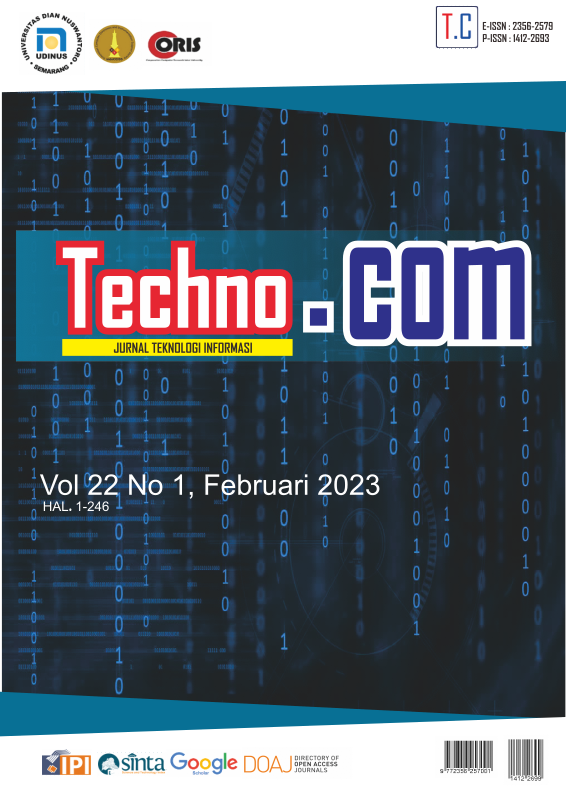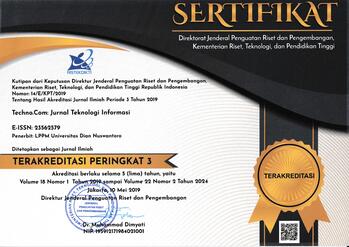Korelasi Controller dan Story Terhadap Game Experience pada Exergames
DOI:
https://doi.org/10.33633/tc.v22i1.7139Keywords:
CEGE, Exergames, Controller, Questionnaire, Game Experience.Abstract
Penyebaran Covid-19 mengakibatkan banyak masyarakat harus mengurangi aktivitas diluar, sehingga mengalami kebosanan selama daring, untuk menghindari kejenuhan salah satu aktivitas dilakukan yaitu bermain game. Pada penelitian ini penulis akan meneliti game olahraga tentang korelasi story dan nonstory serta kontrolernya pada game yang bergenre hampir sama Exergames yaitu Ring Fit Adventure dan Fitness Boxing 2. Penelitian ini akan diuji dengan melakukan pengambilan kuesioner pengalaman kepada 25 responden yakni mahasiswa dengan kisaran umur 18-25 tahun terhadap pengalaman bermain dengan menggunakan metode Core Elements of the Gaming Experience (CEGE) dengan tujuan mempelajari pengalaman bermain game secara objektif. Para responden akan diberi waktu bermain 10 menit setiap permainan. Pengisian kuesioner dengan jumlah 38 pernyataan dengan skala enjoyment, frustration, CEGE, puppetry, video-game. Hasil dari penelitian akan dikelola menggunakan rumus MEAN atau rata-rata dan Standart Deviasi (SD). Dari hasil analisis yang telah dilakukan walaupun tidak memiliki perbedaan yang signifikan, ternyata pemain lebih dominan nyaman pada game Ring Fit Adventure.References
K. Isbister and F. Mueller, “Guidelines for the design of movement-based games and their relevance to HCI,” Human-Computer Interact., vol. 30, no. 3–4, pp. 366–399, May 2015, doi: 10.1080/07370024.2014.996647.
E. Biddiss and J. Irwin, “Active Video Games to Promote Physical Activity in Children and Youth: A Systematic Review,” Arch. Pediatr. Adolesc. Med., vol. 164, no. 7, pp. 664–672, Jul. 2010, doi: 10.1001/ARCHPEDIATRICS.2010.104.
A. Lisa Martin-Niedecken, “Towards Balancing Fun and Exertion in Exergames Exploring the Impact of Movement-Based Controller Devices, Exercise Concepts, Game Adaptivity and Player Modes on Player Experience and Training Intensity in Different Exergame Settings,” 2020, Accessed: Mar. 01, 2022. [Online]. Available: https://tuprints.ulb.tu-darmstadt.de/id/eprint/14186.
F. Revindasari, D. Herumurti, and I. Kuswardayan, “ANALISA PENENTUAN KONTROL UNTUK MOBILE GAME DENGAN GENRE RACING,” SCAN - J. Teknol. Inf. dan Komun., vol. 12, no. 3, pp. 1–8, 2017, doi: 10.33005/SCAN.V12I3.920.
J. J. Wang, T. Baranowski, P. W. C. Lau, R. Buday, and Y. Gao, “Story Immersion May Be Effective in Promoting Diet and Physical Activity in Chinese Children,” J. Nutr. Educ. Behav., vol. 49, no. 4, pp. 321-329.e1, Apr. 2017, doi: 10.1016/J.JNEB.2017.01.001.
K. M. Gerling, M. Klauser, and J. Niesenhaus, “Measuring the impact of game controllers on player experience in FPS games,” Proc. 15th Int. Acad. MindTrek Conf. Envisioning Futur. Media Environ. MindTrek 2011, pp. 83–86, 2011, doi: 10.1145/2181037.2181052.
“(PDF) Pulling the strings: A theory of puppetry for the gaming experience | Paul Cairns - Academia.edu.” https://www.academia.edu/2847252/Pulling_the_strings_A_theory_of_puppetry_for_the_gaming_experience (accessed Aug. 10, 2022).
E. H. Calvillo-Gámez, P. Cairns, and A. L. Cox, “Assessing the Core Elements of the Gaming Experience,” pp. 47–71, 2010, doi: 10.1007/978-1-84882-963-3_4.
D. Herumurti, A. Yuniarti, W. N. Khotimah, I. Kuswardayan, F. Revindasari, and S. Arifiani, “Analysing the user experience design based on game controller and interface,” 2018 Int. Conf. Signals Syst. ICSigSys 2018 - Proc., pp. 136–141, Jun. 2018, doi: 10.1109/ICSIGSYS.2018.8372653.
“Game-based Storytelling Using Role Playing Game and Expansion to Virtual Reality - Diverse Global Research Journals.” https://diverseresearchjournals.com/game-based-storytelling-using-role-playing-game-and-expansion-to-virtual-reality/ (accessed Sep. 04, 2022).
A. Al Mahmud, O. Mubin, S. Shahid, and J. B. Martens, “Designing and evaluating the tabletop game experience for senior citizens,” ACM Int. Conf. Proceeding Ser., vol. 358, pp. 403–406, 2008, doi: 10.1145/1463160.1463205.
E. H. Calvillo-Gámez, “On the Core Elements of the Experience of Playing Video Games: Studying the Gaming Experience,” p. 216, 2009.
D. Desiree, “User experience of games for rehabilitation of children with a chronic condition,” 2018.
I. Reinaldo, N. S. Pulungan, and H. Darmadi, “Prototyping ‘Color in Life’ EduGame for Dichromatic Color Blind Awareness,” Procedia Comput. Sci., vol. 179, pp. 773–780, Jan. 2021, doi: 10.1016/J.PROCS.2021.01.070.
P. Vikberg, “Combined user experience: utilizing built environment in mixed reality gaming,” Aug. 2019, Accessed: Sep. 02, 2022. [Online]. Available: https://aaltodoc.aalto.fi:443/handle/123456789/39863.
J. Halloran and A. Minaeva, “Touch and play? Investigating the value of touchscreens for gamer experience,” Entertain. Comput., vol. 32, p. 100312, Dec. 2019, doi: 10.1016/J.ENTCOM.2019.100312.
P. Gustavsson, “Creation and optimization of motion-based platform game in Unity 3D : How variated levels in amotion based platform game affects performance,” 2019, Accessed: Sep. 02, 2022. [Online]. Available: http://urn.kb.se/resolve?urn=urn:nbn:se:liu:diva-170824.
Downloads
Published
Issue
Section
License
Pernyataan Lisensi
Artikel yang diterbitkan dalam jurnal Techno.Com dilisensikan di bawah Lisensi Creative Commons Atribusi-NonKomersial 4.0 Internasional (CC BY-NC 4.0).
Anda diperbolehkan untuk menyalin, mendistribusikan, menampilkan, dan melakukan karya dari artikel ini serta membuat karya turunan selama Anda memberikan kredit yang sesuai kepada penulis asli dan tidak menggunakan karya ini untuk tujuan komersial. Untuk melihat salinan lisensi ini, kunjungi [Creative Commons Attribution-NonCommercial 4.0 International](https://creativecommons.org/licenses/by-nc/4.0/).
---
Contoh pengkreditan:
- Penulis: [Nama Penulis]
- Judul Artikel: [Judul Artikel]
- Jurnal: Techno.Com, Vol. [Nomor Volume], No. [Nomor Edisi], Tahun [Tahun Penerbitan]
Jika Anda ingin menggunakan karya ini untuk tujuan komersial, Anda harus mendapatkan izin terlebih dahulu dari penulis atau penerbit.
---














